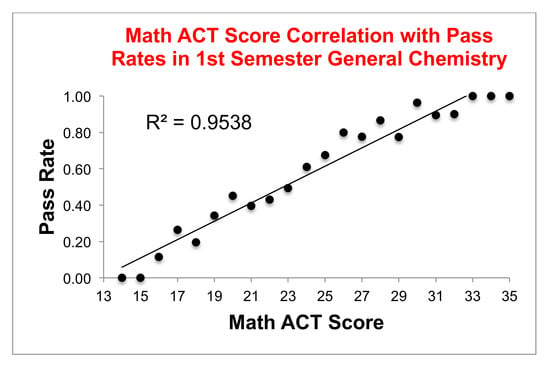Improving the Success of First Term General Chemistry Students at a Liberal Arts Institution
Abstract
:1. Introduction
2. Materials and Methods
2.1. Data Extraction
2.2. Statistical Analysis
3. Results and Discussion
3.1. The First Semester General Chemistry Curriculum
3.2. Higher Failure Rates can Be Correlated to Higher Attrition Rates
3.3. Identifying Mathematically Underprepared Students
3.4. Learner-Centered Pedagogies
Learning Assistant Program
3.5. Preparatory General Chemistry
3.5.1. Preparatory General Chemistry Course Design and Pilot
3.5.2. Preparatory General Chemistry Course Content
3.5.3. Effectiveness of Preparatory General Chemistry in Improving Performance in 1st Semester General Chemistry
4. Conclusions
Author Contributions
Conflicts of Interest
References
- Jones, K.B.; Gellene, G.I. Understanding attrition in an introductory chemistry sequence following successful completion of a remedial course. J. Chem. Educ. 2005, 82, 1241–1245. [Google Scholar] [CrossRef]
- Allenbaugh, R.J.; Herrera, K.M. Pre-assessment and peer tutoring as measures to improve performance in gateway general chemistry classes. Chem. Educ. Res. Pract. 2014, 15, 620–627. [Google Scholar] [CrossRef]
- Graham, M.J.; Frederick, J.; Byars-Winston, A.; Hunter, A.-B.; Handelsman, J. Increasing persistence of college students in STEM. Science 2013, 341, 1455–1456. [Google Scholar] [CrossRef] [PubMed]
- Hall, D.M.; Curtin-Soydan, A.J.; Canelas, D.A. The science advancement through group engagement program: Leveling the playing field and increasing retention in science. J. Chem. Educ. 2014, 91, 37–47. [Google Scholar] [CrossRef]
- Olson, S.; Riordan, D.G. Engage to Excel: Producing one Million Additional College Graduates with Degrees in Science, Technology, Engineering, and Mathematics; Executive Office of the President: Washington, DC, USA, 2012. [Google Scholar]
- Haak, D.C.; HilleRisLambers, J.; Pitre, E.; Freeman, S. Increased structure and active learning reduce the achievement gap in introductory biology. Science 2011, 332, 1213–1216. [Google Scholar] [CrossRef] [PubMed]
- Holme, T.; Luxford, C.; Murphy, K. Updating the general chemistry anchoring concepts content map. J. Chem. Educ. 2015, 92, 1115–1116. [Google Scholar] [CrossRef]
- Luxford, C.J.; Linenberger, K.J.; Raker, J.R.; Baluyut, J.Y.; Reed, J.J.; Silva, C.D.; Holme, T. Building a database for the historical analysis of the general chemistry curriculum using ACS general chemistry exams as artifacts. J. Chem. Educ. 2015, 92, 230–236. [Google Scholar] [CrossRef]
- Holme, T.; Murphy, K. The ACS Exams Institute undergraduate chemistry anchoring concepts content map I: General chemistry. J. Chem. Educ. 2012, 89, 721–723. [Google Scholar] [CrossRef]
- Wagner, E.P.; Sasser, H.; DiBiase, W.J. Predicting students at risk in general chemistry using pre-semester assessments and demographic information. J. Chem. Educ. 2002, 79, 749–755. [Google Scholar] [CrossRef]
- Shields, S.P.; Hogrebe, M.C.; Spees, W.M.; Handlin, L.B.; Noelken, G.P.; Riley, J.M.; Frey, R.F. A transition program for underprepared students in general chemistry: Diagnosis, implementation, and evaluation. J. Chem. Educ. 2012, 89, 995–1000. [Google Scholar] [CrossRef]
- Chan, J.Y.K.; Bauer, C.F. Identifying at-risk students in general chemistry via cluster analysis of affective characteristics. J. Chem. Educ. 2014, 91, 1417–1425. [Google Scholar] [CrossRef]
- Craney, C.L.; Armstrong, R.W. Predictors of grades in general chemistry for allied health students. J. Chem. Educ. 1985, 62, 127–129. [Google Scholar] [CrossRef]
- Spencer, H.E. Mathematical SAT test scores and college chemistry grades. J. Chem. Educ. 1996, 73, 1150–1153. [Google Scholar] [CrossRef]
- Carmichael, J.W.; Bauer, S.J.; Sevenair, J.P.; Hunter, J.T.; Gambrell, R.L. Predictors of first-year chemistry grades for black Americans. J. Chem. Educ. 1986, 63, 333–336. [Google Scholar] [CrossRef]
- Clark, T.M.; Ricciardo, R.; Weaver, T. Transitioning from expository laboratory experiments to course-based undergraduate research in general chemistry. J. Chem. Educ. 2016, 93, 56–63. [Google Scholar] [CrossRef]
- Pfund, C.; Miller, S.; Brenner, K.; Bruns, P.; Chang, A.; Ebert-May, D.; Fagen, A.P.; Gentile, J.; Gossens, S.; Khan, I.M.; et al. Summer institute to improve university science teaching. Science 2009, 324, 470–471. [Google Scholar] [CrossRef] [PubMed]
- Freeman, S.; Eddy, S.L.; McDonough, M.; Smith, M.K.; Okoroafor, N.; Jordt, H.; Wenderoth, M.P. Active learning increases student performance in science, engineering, and mathematics. Proc. Natl. Acad. Sci. USA 2014, 111, 8410–8415. [Google Scholar] [CrossRef] [PubMed]
- Smith, B.L. Learning Communities: Reforming Undergraduate Education, 1st ed.; Jossey-Bass: San Francisco, CA, USA, 2004. [Google Scholar]
- Franier, B.J.D.L.; Diep, J.; Menzies, P.J.C.; Morra, B.; Koroluk, K.J.; Dicks, A.P. A first-year chemistry undergraduate “course community” at a large, research intensive university. J. Chem. Educ. 2016, 93, 256–261. [Google Scholar] [CrossRef]
- Lewis, S.E.; Lewis, J.E. Departing from lectures: An evaluation of a peer-led guided inquiry alternative. J. Chem. Educ. 2005, 82, 135–139. [Google Scholar] [CrossRef]
- Barkley, E.F.; Cross, K.P.; Major, C.H. Collaborative learning techniques. In A Handbook for College Faculty; Jossey-Bass: San Francisco, CA, USA, 2005. [Google Scholar]
- Otero, V.; Pollock, S.; Finkelstein, N. A physics department’s role in preparing physics teachers: The Colorado learning assistant model. Am. J. Phys. 2010, 78, 1218–1224. [Google Scholar] [CrossRef]
- Botch, B.; Day, R.; Vining, W.; Stewart, B.; Rath, K.; Peterfreund, A.; Hart, D. Effects on student achievement in general chemistry following participation in an online preparatory course. J. Chem. Educ. 2007, 84, 547–553. [Google Scholar] [CrossRef]
- ACT. How Schools Use the ACT. Available online: http://www.act.org/content/act/en/products-and-services/the-act/scores/how-schools-use-the-act.html (accessed on 27 November 2017).
- Waratuke, S.; Kling, T. Interdisciplinary research in a dense summer bridge: The role of a writing intensive chemistry seminar. J. Chem. Educ. 2016, 93, 1391–1396. [Google Scholar] [CrossRef]
- Murphy, K. Using a personal response system to map cognitive efficiency and gain insight into a proposed learning progression in preparatory chemistry. J. Chem. Educ. 2012, 89, 1229–1235. [Google Scholar] [CrossRef]
- Wink, D.J.; Gislason, S.F.; Zusman, B.J.; Mebane, R.C. The match program: A preparatory chemistry and intermediate algebra curriculum. J. Chem. Educ. 2000, 77, 999–1000. [Google Scholar] [CrossRef]
- Genyea, J. Improving students’ problem solving skills: A methodical approach for a preparatory course. J. Chem. Educ. 1983, 60, 478–482. [Google Scholar] [CrossRef]
- Cracolice, M.S.; Busby, B.D. Preparation of college general chemistry: More than just a matter of content knowledge acquisition. J. Chem. Educ. 2015, 92, 1790–1797. [Google Scholar] [CrossRef]
- Heller, M.L.; Marchant, G.J. Facilitating self-regulated learning skills and achievement with a strategic content learning approach. Community Coll. J. Res. Pract. 2015, 39, 808–818. [Google Scholar] [CrossRef]
- Elrod, S. Quantitative reasoning: The next “across the curriculum” movement. Peer Rev. 2014, 16, 4–8. [Google Scholar]
- National Leadership Council for Liberal Education & America’s Promise. Executive Summary with Employers’ Views on Learning Outcomes and Assessment Approaches: College Learning for the New Global Century. Available online: https://secure.aacu.org/AACU/PDF/GlobalCentury_ExecSum_3.pdf (accessed on 27 November 2017).
- Slavin, R.E. On making a difference. Educ. Res. 1990, 19, 30–44. [Google Scholar] [CrossRef]
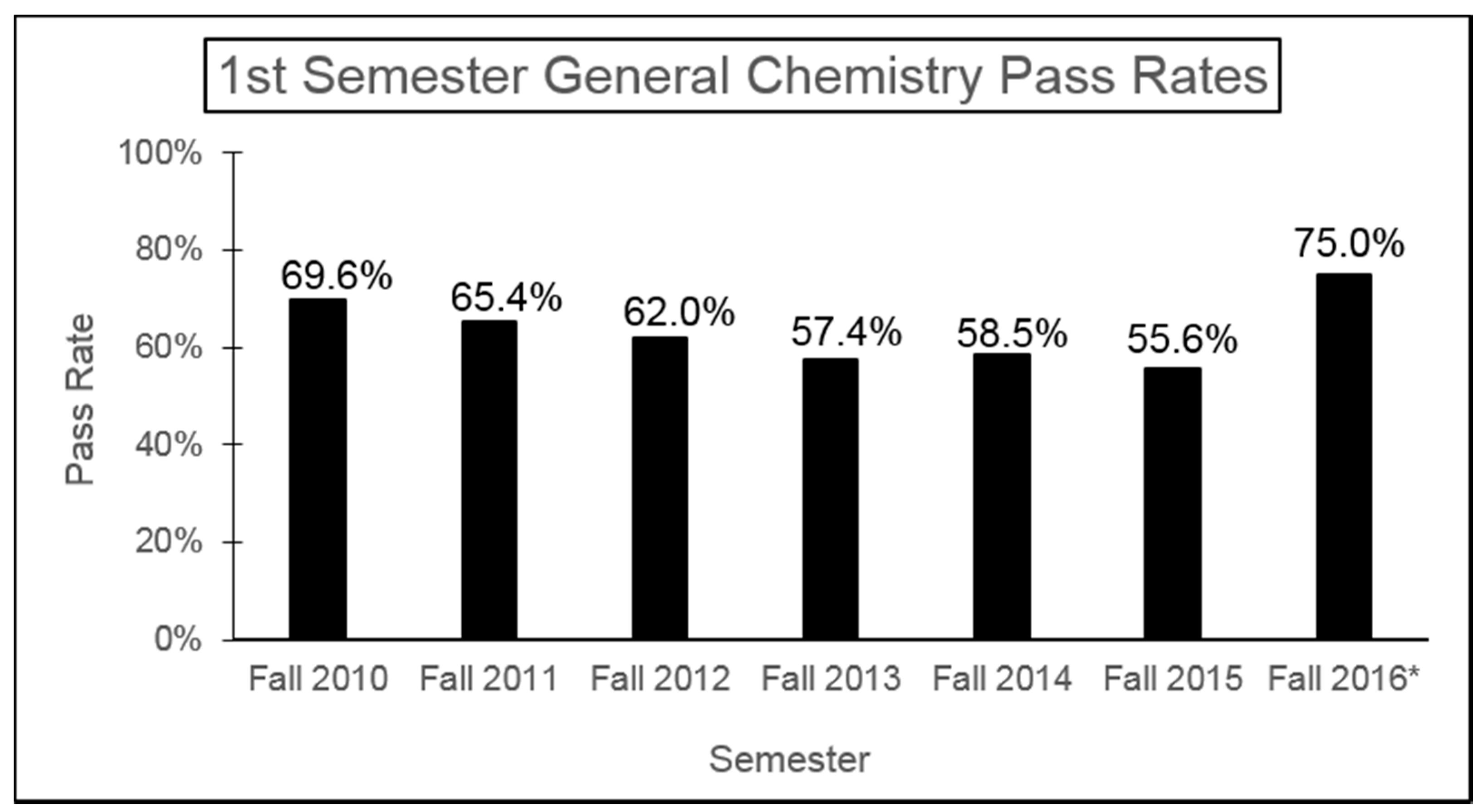
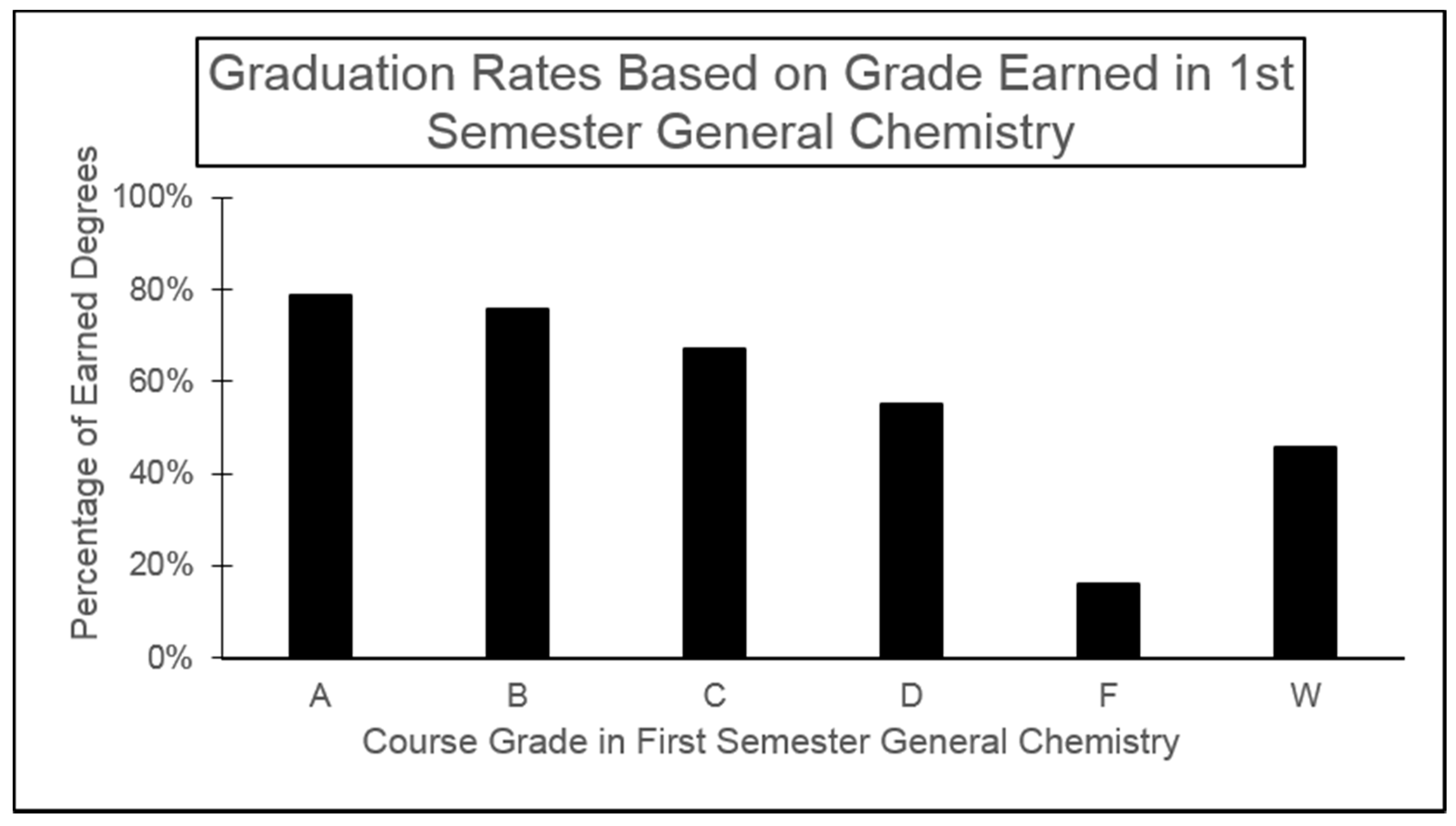
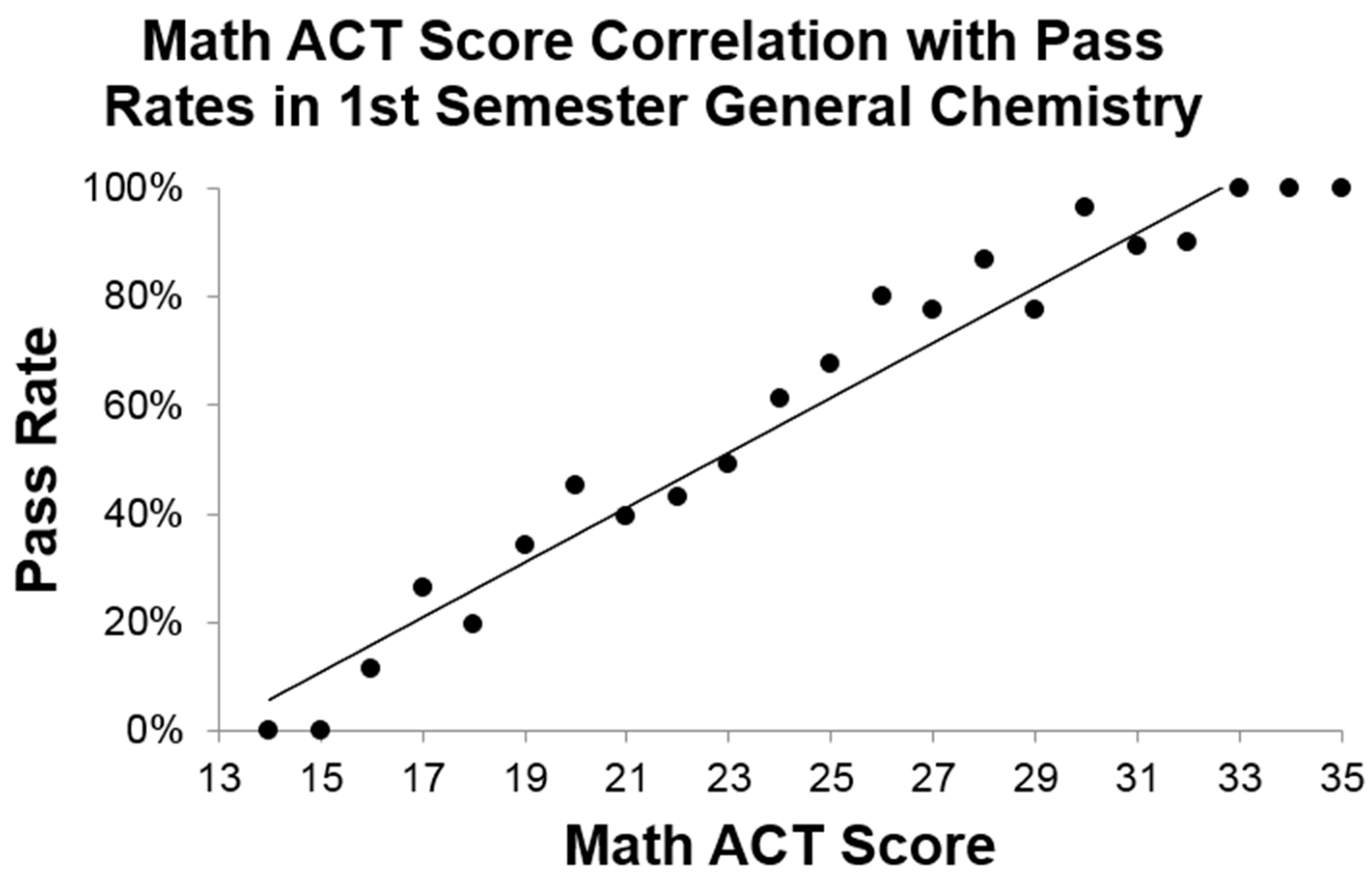
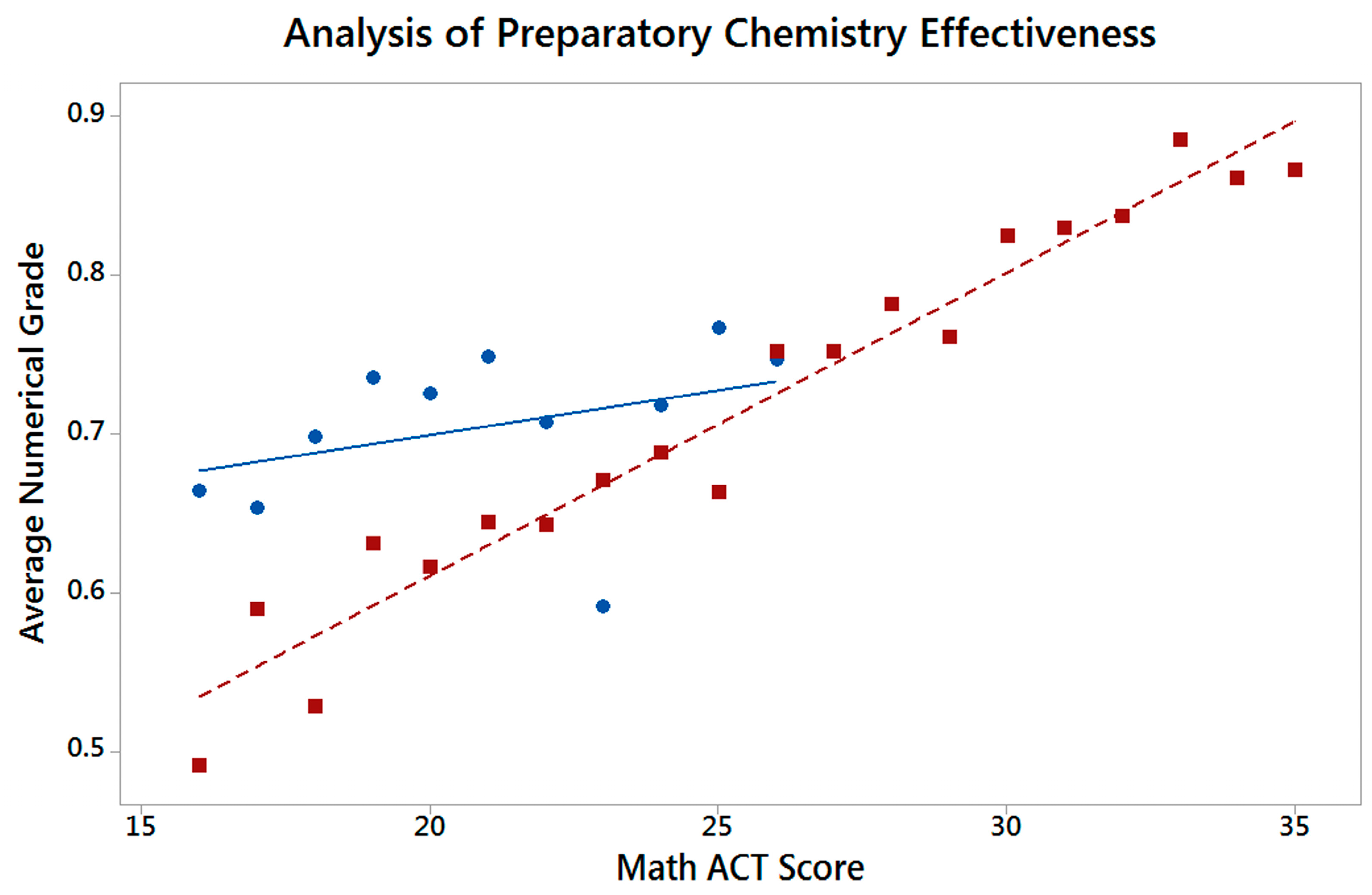
| Traditional Group (N) 1 | Preparatory Chem Group (N) 1 | Average Grade, Traditional | Average Grade, Preparatory Chem Group | Difference | p-Value of Difference | Effect Size | Class Std Dev |
|---|---|---|---|---|---|---|---|
| 244 | 22 | 0.646 | 0.708 | 0.062 | <0.001 | 0.47 | 0.13084 |
| Math ACT | Traditional Group (N) 1 | Preparatory Chem Group (N)1 | Average Grade, Traditional | Average Grade, Preparatory Chem Group | Difference | p-Value of Difference 2 | Effect Size | Class Std Dev |
|---|---|---|---|---|---|---|---|---|
| 18 | 12 | 3 | 0.525 | 0.698 | 0.173 | 0.008 | 1.15 | 0.1506 |
| 19 | 14 | 4 | 0.634 | 0.735 | 0.101 | 0.016 | 0.90 | 0.1118 |
| 20 | 20 | 2 | 0.623 | 0.725 | 0.102 | <0.001 | 0.82 | 0.1243 |
| 21 | 19 | 2 | 0.644 | 0.748 | 0.104 | 0.067 3 | 0.88 3 | 0.1184 |
| 22 | 22 | 2 | 0.642 | 0.707 | 0.065 | 0.015 | 0.52 | 0.1242 |
| 23 | 39 | 2 | 0.673 | 0.591 | −0.082 | 0.953 3 | −0.75 3 | 0.1098 |
| 24 | 55 | 3 | 0.688 | 0.718 | 0.030 | 0.252 3 | 0.28 3 | 0.1080 |
| 25 | 45 | 2 | 0.663 | 0.766 | 0.103 | 0.011 | 0.74 | 0.1386 |
© 2018 by the authors. Licensee MDPI, Basel, Switzerland. This article is an open access article distributed under the terms and conditions of the Creative Commons Attribution (CC BY) license (http://creativecommons.org/licenses/by/4.0/).
Share and Cite
Stone, K.L.; Shaner, S.E.; Fendrick, C.M. Improving the Success of First Term General Chemistry Students at a Liberal Arts Institution. Educ. Sci. 2018, 8, 5. https://doi.org/10.3390/educsci8010005
Stone KL, Shaner SE, Fendrick CM. Improving the Success of First Term General Chemistry Students at a Liberal Arts Institution. Education Sciences. 2018; 8(1):5. https://doi.org/10.3390/educsci8010005
Chicago/Turabian StyleStone, Kari L., Sarah E. Shaner, and Carol M. Fendrick. 2018. "Improving the Success of First Term General Chemistry Students at a Liberal Arts Institution" Education Sciences 8, no. 1: 5. https://doi.org/10.3390/educsci8010005
APA StyleStone, K. L., Shaner, S. E., & Fendrick, C. M. (2018). Improving the Success of First Term General Chemistry Students at a Liberal Arts Institution. Education Sciences, 8(1), 5. https://doi.org/10.3390/educsci8010005





